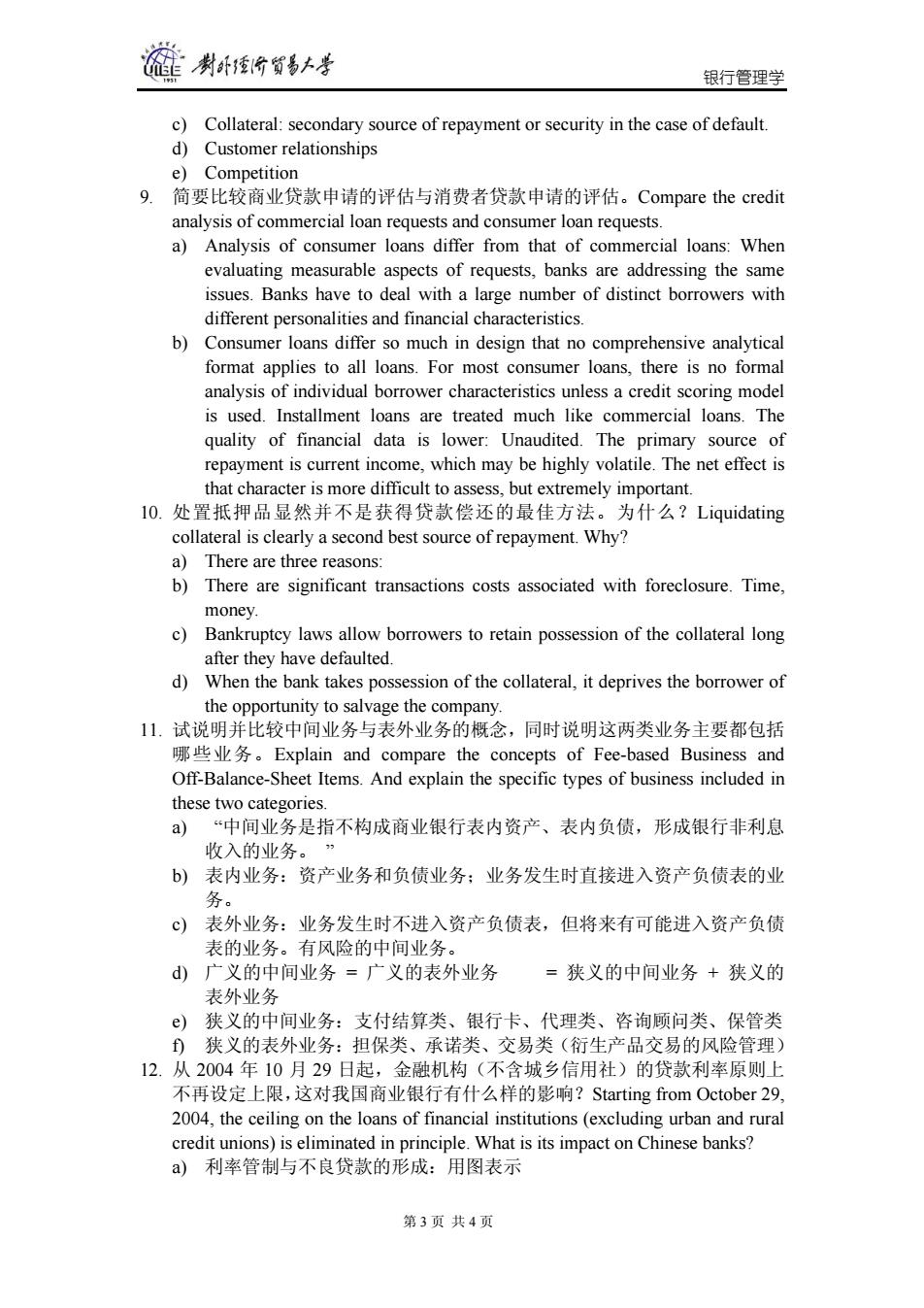正在加载图片...

”制卧台贸易上兰 银行管理学 c)Collateral:secondary source of repayment or security in the case of default. d)Customer relationships e)Competition 9.简要比较商业贷款申请的评估与消费者贷款申请的评估。Compare the credit analysis of commercial loan requests and consumer loan requests. a)Analysis of consumer loans differ from that of commercial loans:When evaluating measurable aspects of requests,banks are addressing the same issues.Banks have to deal with a large number of distinct borrowers with different personalities and financial characteristics. b)Consumer loans differ so much in design that no comprehensive analytical format applies to all loans.For most consumer loans,there is no formal analysis of individual borrower characteristics unless a credit scoring model is used.Installment loans are treated much like commercial loans.The quality of financial data is lower:Unaudited.The primary source of repayment is current income,which may be highly volatile.The net effect is that character is more difficult to assess,but extremely important. l0.处置抵押品显然并不是获得贷款偿还的最佳方法。为什么?Liquidating collateral is clearly a second best source of repayment.Why? a)There are three reasons: b)There are significant transactions costs associated with foreclosure.Time, money. c)Bankruptcy laws allow borrowers to retain possession of the collateral long after they have defaulted. d)When the bank takes possession of the collateral,it deprives the borrower of the opportunity to salvage the company. 11.试说明并比较中间业务与表外业务的概念,同时说明这两类业务主要都包括 哪些业务。Explain and compare the concepts of Fee-based Business and Off-Balance-Sheet Items.And explain the specific types of business included in these two categories. )“中间业务是指不构成商业银行表内资产、表内负债,形成银行非利息 收入的业务。” b)表内业务:资产业务和负债业务:业务发生时直接进入资产负债表的业 务。 ©)表外业务:业务发生时不进入资产负债表,但将来有可能进入资产负债 表的业务。有风险的中间业务。 d)广义的中间业务=广义的表外业务 =狭义的中间业务+狭义的 表外业务 )狭义的中间业务:支付结算类、银行卡、代理类、咨询顾问类、保管类 D狭义的表外业务:担保类、承诺类、交易类(衍生产品交易的风险管理) 12.从2004年10月29日起,金融机构(不含城乡信用社)的贷款利率原则上 不再设定上限,这对我国商业银行有什么样的影响?Starting from October29, 2004,the ceiling on the loans of financial institutions(excluding urban and rural credit unions)is eliminated in principle.What is its impact on Chinese banks? a)利率管制与不良贷款的形成:用图表示 第3页共4页银行管理学 c) Collateral: secondary source of repayment or security in the case of default. d) Customer relationships e) Competition 9. 简要比较商业贷款申请的评估与消费者贷款申请的评估。Compare the credit analysis of commercial loan requests and consumer loan requests. a) Analysis of consumer loans differ from that of commercial loans: When evaluating measurable aspects of requests, banks are addressing the same issues. Banks have to deal with a large number of distinct borrowers with different personalities and financial characteristics. b) Consumer loans differ so much in design that no comprehensive analytical format applies to all loans. For most consumer loans, there is no formal analysis of individual borrower characteristics unless a credit scoring model is used. Installment loans are treated much like commercial loans. The quality of financial data is lower: Unaudited. The primary source of repayment is current income, which may be highly volatile. The net effect is that character is more difficult to assess, but extremely important. 10. 处置抵押品显然并不是获得贷款偿还的最佳方法。为什么?Liquidating collateral is clearly a second best source of repayment. Why? a) There are three reasons: b) There are significant transactions costs associated with foreclosure. Time, money. c) Bankruptcy laws allow borrowers to retain possession of the collateral long after they have defaulted. d) When the bank takes possession of the collateral, it deprives the borrower of the opportunity to salvage the company. 11. 试说明并比较中间业务与表外业务的概念,同时说明这两类业务主要都包括 哪些业务。Explain and compare the concepts of Fee-based Business and Off-Balance-Sheet Items. And explain the specific types of business included in these two categories. a) “中间业务是指不构成商业银行表内资产、表内负债,形成银行非利息 收入的业务。 ” b) 表内业务:资产业务和负债业务;业务发生时直接进入资产负债表的业 务。 c) 表外业务:业务发生时不进入资产负债表,但将来有可能进入资产负债 表的业务。有风险的中间业务。 d) 广义的中间业务 = 广义的表外业务 = 狭义的中间业务 + 狭义的 表外业务 e) 狭义的中间业务:支付结算类、银行卡、代理类、咨询顾问类、保管类 f) 狭义的表外业务:担保类、承诺类、交易类(衍生产品交易的风险管理) 12. 从 2004 年 10 月 29 日起,金融机构(不含城乡信用社)的贷款利率原则上 不再设定上限,这对我国商业银行有什么样的影响?Starting from October 29, 2004, the ceiling on the loans of financial institutions (excluding urban and rural credit unions) is eliminated in principle. What is its impact on Chinese banks? a) 利率管制与不良贷款的形成:用图表示 第 3 页 共 4 页